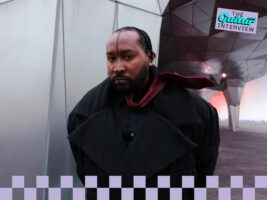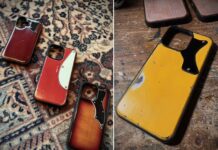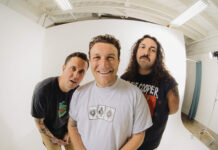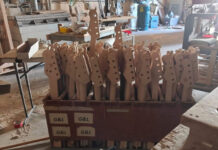
How Bartees Strange deconstructed genre – and his guitar playing – on new album Horror
“Everything seems normal, but something’s really wrong,” Bartees Strange says, reflecting for a moment on the way the songs on his new record have been constructed to mirror its title. Throughout Horror there are moments when everything tilts, allowing scratchy, needling solos to break through placid waters, or Sabbath-esque riffs to bite through supine jams.
“There’s something erupting from this,” he continues. “There are these beautiful things, and there’s something that completely splits them in half. It comes out and you can’t stop it. There’s a world where everything feels pretty nostalgic, or like things I’ve felt and heard or said before, and then something happens that escalates the situation.”
READ MORE: How sibling duo ALT BLK ERA are smashing down guitar barriers on debut album Rave Immortal
In following up 2022’s sublime Farm to Table, Bartees has leaned into the fears and coping mechanisms of his youth. Growing up as a queer Black person in the very white, very conservative surroundings of Mustang, Oklahoma, horror movies and scary stories were swallowed whole as life lessons in a world that was actively out to get him. “I was a nervous kid,” he says.
“I fell in love with horror movies as this way of getting used to being afraid and wanting to be better at being afraid, if that makes any sense. The unifying idea with horror is that there are so many things in life that are big and scary and seem really hard to get around, but you have to go through them and to get over them. If you can do that, then you can eventually become a more actualised version of yourself.”
Image: Elizabeth De La Piedra
Keep Learning
Now aged 36, the actualised Bartees is wise to the idea that you can’t simply stop learning more about how you function in the world. On Horror he constantly picks off scabs, leaving grown-up anxieties raw and bloody in a manner that seeks to connect with the visceral unknowns of his younger years. He views personal development and heavyweight decisions as Ari Aster might regard composite elements in a freakish tableau.
“Baltimore is a song about not knowing where to settle down,” he says. “Where is an affordable, safe, nice place to live? There are songs like 17 where, as I get older, there are still moments when I feel like I have no idea what’s going on. I feel like when I was on the precipice of adolescence, you know? Seventeen, going to college, everything’s about to be brand new.”
In many ways, Bartees’ discography to date has already tapped into this feeling of revisiting old emotions and influences in order to recontextualise them. His work is deeply referential – over the past five years and change he’s pulled swatches from formative years spent immersed in post-hardcore and emo, made a The National covers record, and frequently lit up skittering rap verses with scratchy, responsive riffs, always finding a way to centre his own charismatic performances.
On Horror he does the same things, but with a small twist. Here, many of the sounds he draws parallels between come not to his own first-hand experiences but those of his folks, an opera singer mother and ex-military father. He pulls from the sounds that lit up his childhood, reframing them as elements to be corrupted and turned inwards, comforting sounds becoming serrated or otherworldly. “I get caught up in eras,” he says. “For a big chunk of this record, something I was really in love with was the late 60s to early 80s, the music that my parents grew up listening to.”
“I think about stories like Rick James playing in Neil Young’s band,” he continues. “Rick goes to jail, and Neil becomes a superstar, and everyone in jail doesn’t believe Rick when he’s like, ‘That’s my friend.’ Then he comes out and becomes Rick James. When people listen to that music, they don’t think of those two as people with sonically similar worlds who were able to hold space for each other, and have a life that was dependent on each other. I love these things that deconstruct how we see genre.”
Young Man
Fittingly, Young is a prominent presence on Baltimore, which settles into the loping gait of Harvest’s opener Out on the Weekend before Bartees’ guitar breaks in like a bottle thrown across a quiet town square. “I used a ‘54 Gibson J-160E, no amp except for the solo,” he says. “Those guitars have a Gibson pickup in them and you can do crazy solos. You’re limited – it’s not made to move fast on, so you end up in Neil Young mode. You’re on one string over and over again, trying to speak. That’s my style of playing. I’m not a dancer, I’m not a licker. I’m a bender, a puller, a hitter.”
On Hit It Quit It, meanwhile, we’re temporarily transported to George Clinton’s P-Funk universe before Sober slides into peak Fleetwood Mac territory, dialling up family favourites that Bartees initially reacted to with slouchy teenage contempt. “I was forced to listen to it and ended up loving it,” he admits. “My dad was like a Deadhead for Funkadelic — that was the biggest band I ever knew of as a child.”
“Then I found out about Fleetwood Mac, and that these bands were making music during the exact same time,” he continues. “There’s no way they didn’t listen to each other’s music, even though some were black and some were white or whatever. They were great artists who respected each other. They were probably like, ‘Whoa, how did he make his guitar sound that way?’ Eddie Hazel sounds crazy, like Led Zeppelin, you know what I mean? All of these musicians are referential to each other. I wanted to distill it through my way of seeing sound.”
Hunkering Down
Horror came together across a three year span at Bartees’ studio space in Baltimore, with his hunkered-down, detail-obsessed style bookended by contributions from Yves Tumor and Lawrence Rothman and Jack Antonoff, whose varied expertise was put to specific uses. “Each of the people who worked on the record did something on other records that I wanted on my record,” Bartees says. “With Yves and Lawrence, I was like, ‘How did they make that Yves Tumor record?’ It feels so alive, and so played, and it’s like hip hop drums on a rock production, rock drums on a blues or jazz production.”
He got in a room with them to better understand their approach and emerged with the drum sounds for Sober, Too Much and Hit It Quit It. “I wanted this ‘70s rhythm thing, and I wanted it to be ugly but not fucked up,” he says. Antonoff, meanwhile, entered the fray right at the end, having bumped into Bartees at a festival. “I wanted more dynamic range,” he says. “I wanted the small moments to be smaller and the big moments to be bigger. I had already produced the album and then I met him. He was like, ‘Oh, dude, I have so many ideas for how we can punch this up.’ That was huge. That took the record from 80% to 100%.”
In a similar manner to his use of the J-160E to dredge up a very specific sound, while tracking Horror Bartees trusted instruments that could bring to life the things he was hearing in his head. Several tracks were written on bass — among them Hit It Quit It and Loop Defenders — and the approach there was very much to bring out gut-level low end. “I played bass on probably half the songs using a ‘67 Duo-Sonic,” Bartees says. “It’s just one little single coil pickup and it’s got flats on it. It’s ugly and bumpy, which is kind of the spirit of the record.”
Just Enough
To deliver Too Much’s increasingly antic, fuzz-bound soul, meanwhile, he ran his cherished ‘59 Jazzmaster, an ES-335 and a Telecaster on the bridge pickup through a Chase Bliss Warped Vinyl and a Vibro Champ. “With those three I was creating a really slimy kind of vibe,” he says. That Vibro Champ, invariably cranked, stayed in the mix throughout, with particular influence on Wants Needs and the closer Backseat Banton when in tandem with Bartees’ prized ‘65 Epiphone Casino and a Gibson ES-125T. “You know, it’s just all P-90s,” he says.
“I have a lot of guitars, honestly, too many,” he continues. “I’m looking at my bank account and I think I’m about to let a bunch go. But that Casino, there’s something about those old P-90s. I played the new Gibson 330 and it sounds great, but it’s way darker, not even close to the same pickups. There’s something bright and spanky and chirpy, it drives so responsively to your hands. That makes that guitar so good for me — a lot of the time I don’t play with a pick. I’m mostly pulling strings, so I need it to break up or be hyper-responsive.”
This attention to detail and understanding of his style means that, no matter how many elements are in play, the light is always drawn to Bartees’ own playing. In an interview focused on his breakout release Live Forever in 2020, he posited that guitar was his home base — wherever his music took him, he’d be heading back that way eventually.
Having come up watching “the old chicken pickers and clawhammer players all day” in Oklahoma, he immersed himself in hardcore, hip hop and indie-rock before pulling all of these threads together. Horror is a real flex in this regard, with gnarled, emotionally-resonant solos played off against yacht-rock breeziness and a whole lot of characterful, dynamic leads that split the difference between TV on the Radio and Knapsack.
“It was me being a little more naked with the songs and what I actually enjoy doing,” Bartees says. “I wasn’t trying to make something for others, but make something I really wanted to play all the time. I think that’s why all the songs are so fun. I want to play [sings Hit It Quit It’s riff] every night. I want to play like Neil Young every night. I want to play freaking Wants Needs like Thom Yorke plays guitar. I want to do all that shit as a guitar player. I let myself do what I wanted.”
Horror is out on February 14 through 4AD.
The post How Bartees Strange deconstructed genre – and his guitar playing – on new album Horror appeared first on Guitar.com | All Things Guitar.
Source: www.guitar-bass.net













